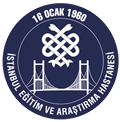ABSTRACT
Objectives:
The aim of the study was to evaluate the results of the nephrolithotomy procedures in horseshoe kidneys.
Methods:
Five patients (4 males, 1 female) with renal calculi and horseshoe kidney, aged between 28-48 years, with an average calculi size of 962 mm2 (150-1560) underwent percutaneous nephrolithotomy procedures between September 2005 and August 2010.
Results:
The overall stone-free rate was 80% (4/5). One patient with a residual calculus had extracorporeal shock wave lithotripsy and became stone-free. The mean operation time was 164 (90-245) minutes, and the mean scopy time was 7 (6-9) minutes. One patient with continuing hematuria who had blood transfusion needed renal angiography, was diagnosed as pseudoaneurysm, and underwent selective angioembolization. None of the patients had postoperative fever or other complications of the lung or bowels.
Conclusion:
Percutaneous nephrolithotomy is a safe and successful technique for renal calculi in horseshoe kidneys.



